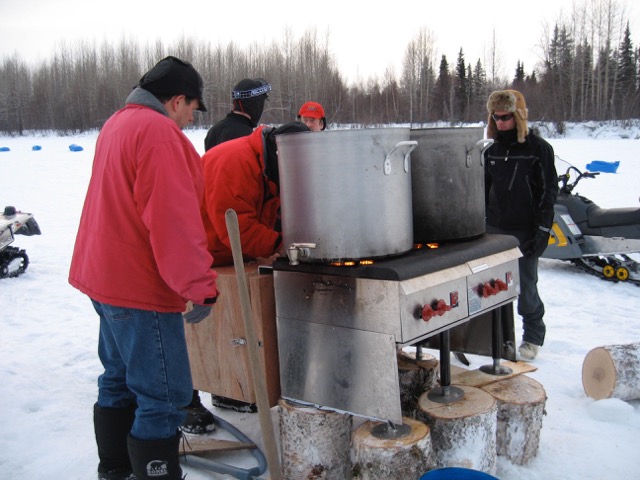Have you seen Dallas Seavey’s video about the boots he created for the Iditarod Trail this year? The six-time champion shared his new footwear system shortly after the race concluded. In the video, he talked about the types of problems he hoped to solve by rethinking the entire concept of footwear on the trail. Seavey wanted the boots to be lightweight, versatile, and warm. Most importantly, he needed the boots to have a system for wicking moisture away from his feet. Through this new, multi-layered approach, Dallas uses materials that he already has to create something new.

Dallas Seavey with Golden Harness winner Aero, and Dan Seavey, his grandfather, at the finishers banquet in 2024. Photo: K. Newmyer
In April Lesson Plan TOTT, I hope you will have a similar spirit of innovation with your students. In this lesson the problem students must solve is to keep warm drinks from freezing. Mushers must stay hydrated on the trail. The cold dry air of the Alaskan winter climate means that while your body is exerting itself, it sweats to stay cool. So there is a need to drink lots of water. In this lesson, you and your students will use items that mushers typically have in their possession to create and test an insulation system for the bottle.
Insulation is a really interesting scientific concept. We use it every day. For example, the moment we get dressed, we are adding an insulating layer to our bodies. Insulation slows the transfer of heat from hot objects to cold ones. Heat can travel via conduction. An example of this is when a pot handle gets hot because the pot is sitting on a hot stove. Convection is another way that heat is passed through liquids or air as heat rises. Finally, heat can be transferred through radiation, as when we feel the heat from a warm campfire.
This lesson will get students thinking about the types of materials mushers carry or wear that can be used to help keep a bottle of warm water from freezing too quickly. Students should think about the layers that might make the best insulation, as well as in what order they should be placed around the bottle. Finally, students can consider materials that help mitigate radiation. Students will be able to think about the insulating properties of various materials.

Gas stove heating water for all mushers in Skwentna. Photo: Iditarod Media
When I did this experiment with participants at the 2023 Iditarod Education Winter Conference, we placed the water bottles outside in the cold to test in real conditions! A question that came up was, how does the sun affect the temperature change? In this case, the sun was our friend, slowing the liquid’s rate of cooling. If I did this experiment with students here in Texas, where the high for today is already 80 degrees, I would place the bottles in a refrigerator or freezer to simulate winter conditions.
I hope you have fun with this experiment! After trying water, could you try other beverages mushers might put in their bottles? Hot tea, coffee, or the ubiquitous Tang? Let me know how your experiments go by emailing me at emailtheteacher@iditarod.com.


